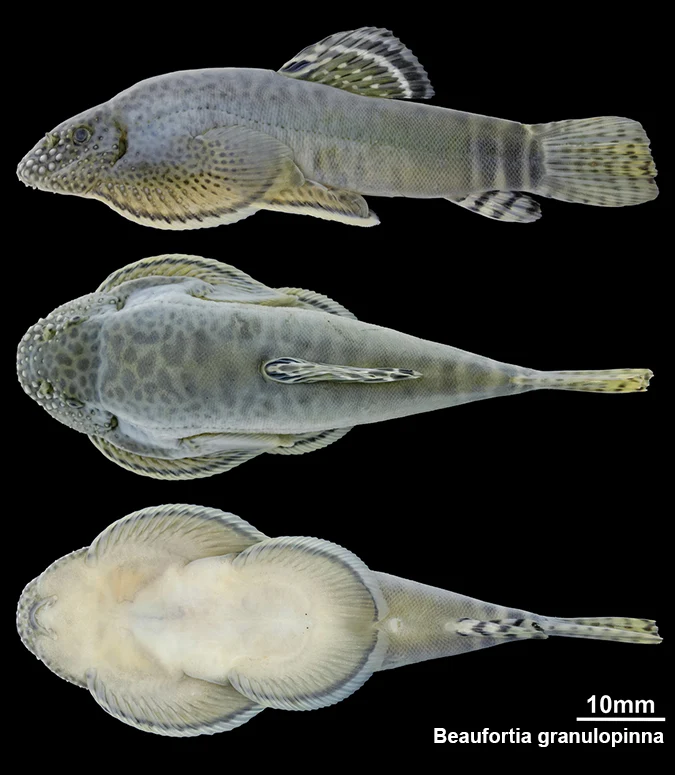NEWS - In the 21st century, new species are often discovered by accident. Researchers discover new species only to learn that they are already endangered. Jing-Chen Chen of Shanghai Ocean University and his team, along with researchers from Yunnan Agricultural University, have identified two new species from the upper Pearl River system in southwest China.
The two fish species face major threats from pollution and overfishing. Jing-Chen Chen of Shanghai Ocean University and his team conducted the study Beaufortia granulopinna and Beaufortia viridis are members of the Gastromyzontidae family known as hillstream suck-loaches.
These fish are highly specialized with compressed bodies, flat bottoms, and paired fins that flare out into suction-cup-like structures. These adaptations allow them to attach to rocky substrates, resisting currents while feeding on algae and invertebrates.
Loaches prefer fast-flowing water, but damming projects can easily lead to regional extinctions. Their low tolerance for pollution and sensitivity to changes in water quality have also contributed to significant population declines.
B. viridis in Wuming District, Nanning City, most of the small tributaries that have been modified into reservoirs for water storage and the tributaries near agricultural irrigation areas have been polluted, making the areas unsuitable for their survival.
However, surprisingly, stable populations have been found within commercial eco-tourism sites that have been left untouched to satisfy consumers' desire for "pure nature".
The researchers suggest that future efforts should focus on increasing attention to this species, conducting in-depth research and further exploring its scientific potential, raising awareness of sustainable habitat conservation to ensure harmonious coexistence between humans and nature.
Original source:
Chen J-C, Li J-J, Tang W-Q, Pu X-R, Lei H-T (2024) Taxonomic resolution of the hillstream suck-loach Beaufortia pingi species group (Cypriniformes, Gastromyzontidae) and two new species from Southwest China– Beaufortia granulopinna and Beaufortia viridis. Zoosystematics and Evolution 100(3): 941-963. DOI:10.3897/zse.100.124370
The two fish species face major threats from pollution and overfishing. Jing-Chen Chen of Shanghai Ocean University and his team conducted the study Beaufortia granulopinna and Beaufortia viridis are members of the Gastromyzontidae family known as hillstream suck-loaches.
These fish are highly specialized with compressed bodies, flat bottoms, and paired fins that flare out into suction-cup-like structures. These adaptations allow them to attach to rocky substrates, resisting currents while feeding on algae and invertebrates.
Loaches prefer fast-flowing water, but damming projects can easily lead to regional extinctions. Their low tolerance for pollution and sensitivity to changes in water quality have also contributed to significant population declines.
B. viridis in Wuming District, Nanning City, most of the small tributaries that have been modified into reservoirs for water storage and the tributaries near agricultural irrigation areas have been polluted, making the areas unsuitable for their survival.
However, surprisingly, stable populations have been found within commercial eco-tourism sites that have been left untouched to satisfy consumers' desire for "pure nature".
The researchers suggest that future efforts should focus on increasing attention to this species, conducting in-depth research and further exploring its scientific potential, raising awareness of sustainable habitat conservation to ensure harmonious coexistence between humans and nature.
Original source:
Chen J-C, Li J-J, Tang W-Q, Pu X-R, Lei H-T (2024) Taxonomic resolution of the hillstream suck-loach Beaufortia pingi species group (Cypriniformes, Gastromyzontidae) and two new species from Southwest China– Beaufortia granulopinna and Beaufortia viridis. Zoosystematics and Evolution 100(3): 941-963. DOI:10.3897/zse.100.124370


